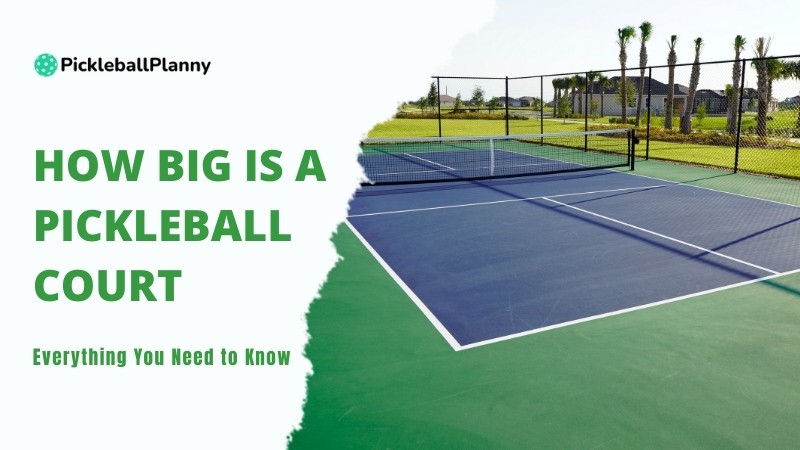Pickleball, a sport that combines elements of tennis, badminton, and table tennis, has been experiencing a surge in popularity in recent years. As more people discover the excitement of this fast-paced game, questions about its fundamentals, such as court size, become increasingly common. So, just how big is a pickleball court? Let’s delve into the dimensions and various aspects of pickleball courts to provide a comprehensive understanding.
How Big is a Pickleball Court
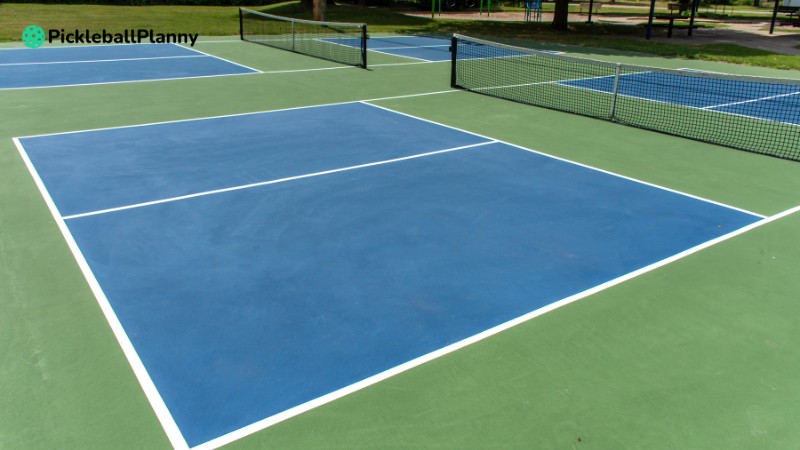
A pickleball court is very similar in size to a doubles badminton court. The official dimensions of a pickleball court, as regulated by the United States of America Pickleball Association (USA Pickleball), are:
- Length of a Pickleball Court: The standard length of a pickleball court is 44 feet, with variations allowed for recreational play. The length of the court plays a crucial role in the dynamics of the game, allowing players enough space to maneuver and engage in rallies effectively.
- Width of a Pickleball Court: In terms of width, a pickleball court measures 20 feet for both singles and doubles play. The width impacts gameplay significantly, influencing shot selection, court coverage, and strategy.
- Service Areas: The service areas, also known as the “service boxes,” are located on each side of the net. They measure 10 feet deep and 15 feet wide. These areas are where players must stand to serve, ensuring a fair and consistent start to each point.
It’s important to note that these measurements include the lines themselves. In addition to the playing area, it’s also recommended to have a clear space around the court. USA Pickleball recommends a minimum total area of 30 feet by 64 feet, which provides an additional 10 feet of space on either side and behind the court. This extra space helps with safety and ease of play.
Read more blog: Is Pickleball an Olympic Sport?
Pickleball court components
The Pickleball court is designed with many components and has its own uses. Include:
Non-Volley Zone
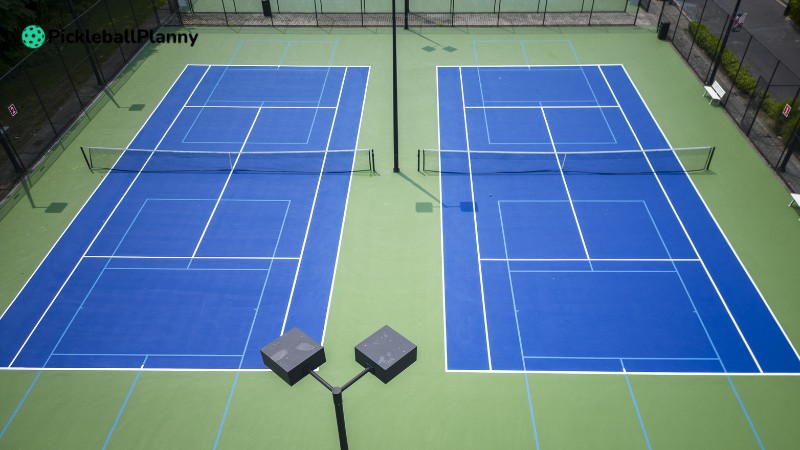
One of the unique features of pickleball is the non-volley zone, commonly referred to as the “kitchen.” This area extends 7 feet (2.13-meter) from the net on both sides and helps prevent players from executing smashes or volleys while too close to the net, promoting longer rallies and strategic shot placement. A serving player is not allowed to volley the ball (hit the ball before it bounces) within the non-volley zone.
Playing Surface
Pickleball courts can be played on a variety of surfaces, including concrete, asphalt, wood, and even grass. The most common surfaces are concrete and asphalt, which can be resurfaced with a special acrylic coating to create a consistent playing experience.
Lines
The lines on a pickleball court are similar to those on a tennis court, but with some key differences. The court is divided into two equal halves by a net, and there are baseline, sideline, and non-volley zone (also known as the kitchen) lines on each side. All lines are 2 inches (5 centimeters) wide and typically painted white or yellow.
Net
The net is a standard badminton net, with a height of 36 inches (91.4 centimeters) at the center and sloping slightly down to 34 inches (86.4 centimeters) at the posts. The net is attached to posts that are located 2 feet (61 centimeters) outside of the sideline on each side of the court.
Optional Components
In addition to the essential components listed above, some pickleball courts may also include optional features such as:
- Fencing: Fencing around the perimeter of the court can help to keep the ball in play and prevent injuries.
- Lighting: Courts that are used for night games will need to be properly lit.
- Seating: Seating for players and spectators can be a welcome addition to any pickleball court.
- Scoreboard: A scoreboard is a helpful tool for keeping track of the score during a game.
Note when building a Pickleball court
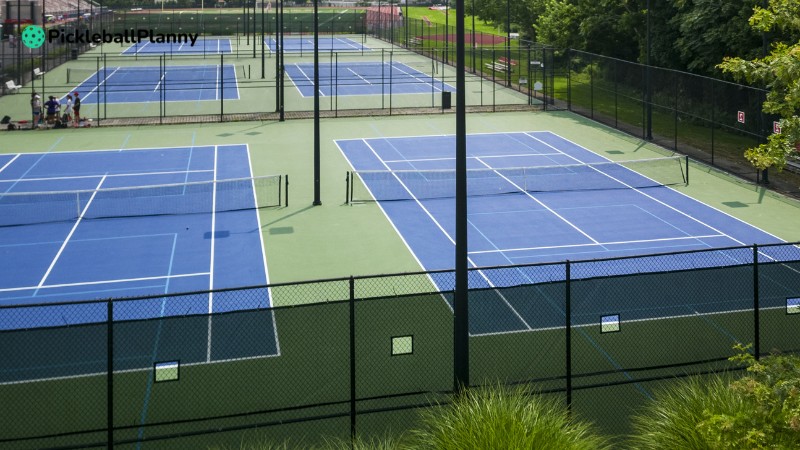
Constructing a pickleball court can be done DIY or by hiring professionals. Factors such as budget, time, and desired quality should be considered when deciding the best approach for court construction. Here are some important notes to consider when building a pickleball court:
Court Surface
Pickleball courts can be constructed using various materials, including asphalt, concrete, or even dedicated pickleball court surfaces. The choice of surface impacts gameplay, with smoother surfaces facilitating faster play and more controlled movement.
Lighting Considerations
Adequate lighting is essential for pickleball courts, especially for evening or indoor play. Proper lighting ensures visibility of the ball and surroundings, reducing the risk of accidents and enhancing the overall playing experience.
Overhead Obstructions
Overhead obstructions, such as trees or buildings, can affect gameplay by casting shadows or interfering with ball trajectory. When selecting a location for a pickleball court, it’s essential to consider potential obstructions and their impact on gameplay.
Surrounding Area
In addition to the court itself, ample space around the court is necessary to accommodate players, spectators, and safety buffers. A well-designed surrounding area enhances the overall playing experience and allows for comfortable viewing and movement.
Pickleball Court Construction
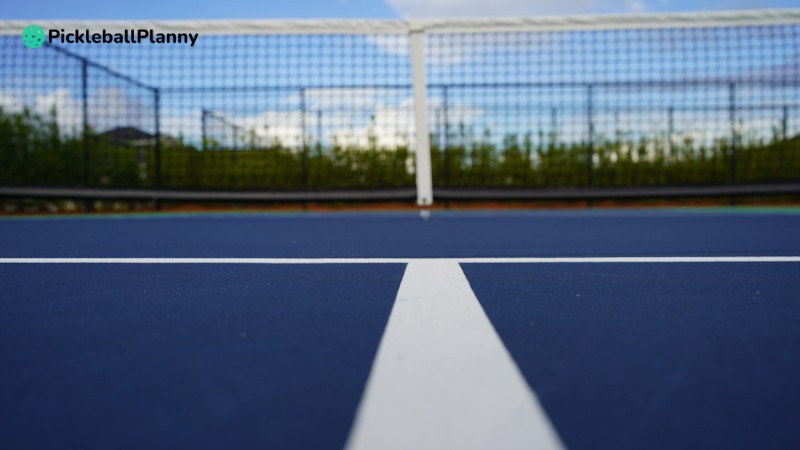
Constructing a pickleball court can be done DIY or by hiring professionals. Factors such as budget, time, and desired quality should be considered when deciding the best approach for court construction.
Quality equipment is essential for enjoying pickleball to its fullest potential. From nets and paddles to balls and court markers, investing in reliable accessories enhances safety and gameplay.
Understanding and adhering to pickleball etiquette is crucial for fostering a positive playing environment. Respect for opponents, adherence to rules, and good sportsmanship are fundamental principles of the game.
Conclusion
In conclusion, the size of a pickleball court is standardized to ensure fairness and consistency in gameplay. Understanding the dimensions and various elements of a pickleball court is essential for players of all skill levels. Whether you’re a seasoned veteran or new to the game, exploring the nuances of pickleball court dimensions can enhance your appreciation and enjoyment of this exciting sport.

